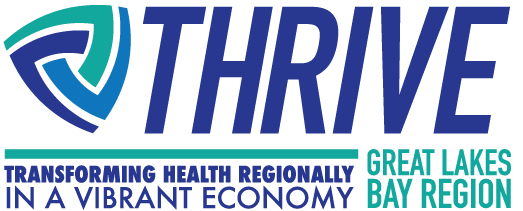
Develop a Regional Health Education Hub
THRIVE envisions all university and health systems as working together to provide efficient health care, a shared learning environment, and provide some public health needs. We will focus on stopping the duplication of efforts in hospitals and education. We seek to make the region nationally recognized and the most appealing for students seeking careers in healthcare.
-
If you are interested in learning more about THRIVE email: admin@thrivegreatlakesbay.org
-
If you would like to print, make a PDF or copy the URL to this page, please scroll to the top of this page and use the following buttons located in the upper left-hand portion that look like this:

- Click Here to Find Funding Opportunities
- Click Here For Promising Practices
THRIVE Health Education Hub Dashboard of Indicators
Up to Date Progress
The progress-tracking graphic above is a handy visual aid designed for a "quick glance" update. The graphic color will update as we continue towards a path of successful completion of this intervention.




Implementation Stage Expansion Stage Scaling Stage Sustainability Stage
- Red: Signifies no work has been completed
- Orange: Signifies a plan has been created to begin work on the intervention
- Yellow: Signifies action has been created for the intervention
- Light Green: Signifies action has begun towards executing all of the objectives and some strategies are completed
- Dark Green: Signifies significant progress towards completion of all objectives
Intervention Progress per Objective and Strategy
Learn more by exploring the objectives below
Objective 1: Explore potential scope and options for medical school consolidation
Strategy 1.1 - Stakeholder dialogue
- Responsible Party: Central Michigan University & Regional Health System
- Progress Highlights and Significance: Stakeholder engagement continues to involve: higher education leaders, major philanthropic and economic development partners, regional hospitals, and public health departments. In 2019, CMU continued to gather input from faculty, staff, community stakeholders regarding benefits and considerations for: Student Success (Enhanced training, Increased number of STEM-Allied Health Graduate Degrees, Access to services and programs on par with leading medical schools in the country). Regional Hospitals' pipeline for heath care workers, including physicians, and a wide-range of allied health occupations.
Strategy 1.2 - Stakeholder Meetings
- Responsible Party: Central Michigan University & Regional Health System
- Progress Highlights and Significance: Stakeholder engagement continues to involve: higher education leaders, major philanthropic and economic development partners, regional hospitals, and public health departments. In 2019, CMU continued to gather input from faculty, staff, community stakeholders regarding benefits and considerations for: Student Success (Enhanced training, Increased number of STEM-Allied Health Graduate Degrees, Access to services and programs on par with leading medical schools in the country). Regional Hospitals' pipeline for heath care workers, including physicians, and a wide-range of allied health occupations.
Strategy 1.3 - Site Selection Exploration
- Responsible Party: Central Michigan University & Regional Health System
- Progress Highlights and Significance: Stakeholder engagement continues to involve: higher education leaders, major philanthropic and economic development partners, regional hospitals, and public health departments. In 2019, CMU continued to gather input from faculty, staff, community stakeholders regarding benefits and considerations for: Student Success (Enhanced training, Increased number of STEM-Allied Health Graduate Degrees, Access to services and programs on par with leading medical schools in the country). Regional Hospitals' pipeline for heath care workers, including physicians, and a wide-range of allied health occupations.
Objective 2: Benchmarking of US-wide medical schools design and coordination of academic and clinical program aspects
Strategy 2.1 - Understand models of healthcare hub
- Responsible Party: Central Michigan University & Regional Health System
- Progress Highlights and Significance: In 2019-20, CMU College of Medicine leadership continued to analyze comparable regional healthcare hub models including how models were funded and implement. Presentations were shared with community stakeholders.
Strategy 2.2 - How to secure funding
- Responsible Party: Central Michigan University & Regional Health System
- Progress Highlights and Significance: In 2019-20, CMU College of Medicine leadership continued to analyze comparable regional healthcare hub models including how models were funded and implement. Presentations were shared with community stakeholders
Strategy 2.3 - How it fits into the plans of the community
- Responsible Party: Central Michigan University & Regional Health System
- Progress Highlights and Significance: In 2019-20, CMU College of Medicine leadership continued to analyze comparable regional healthcare hub models including how models were funded and implement. Presentations were shared with community stakeholders.
Strategy 2.4 - Economic development & health impacts/ what is achieved
- Responsible Party: Central Michigan University & Regional Health System
- Progress Highlights and Significance: In 2019-20, CMU College of Medicine leadership continued to analyze comparable regional healthcare hub models including how models were funded and implement. Presentations were shared with community stakeholders.
Strategy 2.5 - Lessons learned
- Responsible Party: Central Michigan University & Regional Health System
- Progress Highlights and Significance: In 2019-20, CMU College of Medicine leadership continued to analyze comparable regional healthcare hub models including how models were funded and implement. Presentations were shared with community stakeholders.
Objective 3: Research study and consultants
Strategy 3.1 - Collected case studies from universities
- Responsible Party: Central Michigan University & Regional Health System
- Target Completion Date: By the end of 2019
- Progress Highlights and Significance: Numerous case studies have been examined. Of the top 75 medical schools ranked on the U.S. News & World Report survey, 72 (or 96%) are located within a 10-minute drive of the affiliated hospital. Other highly regarded schools are relocating to be closer to their academic teaching hospitals. In 2020, CMU engaged a consultant to gather data on the impact of the 60-minute drive time between CMU’s College of Medicine and the CMU Health campus in Saginaw including limitations on faculty and student access to clinical settings, redundancies, and other factors.
Strategy 3.2 - X distance from academic site
- Responsible Party: Central Michigan University & Regional Health System
- Target Completion Date: By the end of 2019
- Progress Highlights and Significance: Numerous case studies have been examined. Of the top 75 medical schools ranked on the U.S. News & World Report survey, 72 (or 96%) are located within a 10-minute drive of the affiliated hospital. Other highly regarded schools are relocating to be closer to their academic teaching hospitals. In 2020, CMU engaged a consultant to gather data on the impact of the 60-minute drive time between CMU’s College of Medicine and the CMU Health campus in Saginaw including limitations on faculty and student access to clinical settings, redundancies, and other factors.
Strategy 3.3 - Stakeholder interviews
- Responsible Party: Central Michigan University & Regional Health System
- Target Completion Date: By the end of 2019
- Progress Highlights and Significance: Numerous case studies have been examined. Of the top 75 medical schools ranked on the U.S. News & World Report survey, 72 (or 96%) are located within a 10-minute drive of the affiliated hospital. Other highly regarded schools are relocating to be closer to their academic teaching hospitals. In 2020, CMU engaged a consultant to gather data on the impact of the 60-minute drive time between CMU’s College of Medicine and the CMU Health campus in Saginaw including limitations on faculty and student access to clinical settings, redundancies, and other factors.
Objective 4: Investigation
Strategy 4.1 - Trips to Buffalo, Grand Rapids, etc.
- Responsible Party: Central Michigan University & Regional Health System
- Target Completion Date: By the end of 2019
- Progress Highlights and Significance: Site visits and outreach meetings with key leaders at each site were conducted in 2019
Objective 5: Establish long-term clinical partners
Strategy 5.1 - Meet with regional health systems to negotiate for long-term commitment
- Responsible Party: Central Michigan University & Regional Health System
- Data: Central Michigan University 25 Year commitment w/Covenant June 27, 2019
- Target Completion Date: June 2019
- Progress Highlights and Significance: In 2019, a new 25-year affiliation agreement between the CMU College of Medicine and Covenant HealthCare in Saginaw will strengthen their collective support of medical student education and research
Objective 6: Establish Population Health Curriculum and Fellowship for the regional health professional programs
Strategy 6.1 - Establish Population Health Curriculum and Fellowship for the Regional Health Professional Programs
Responsible Party: MidMichigan Family Medicine Residency and MSU Medical Students, CMU Medical School and Residency Programs, the CMU College of Health Professions, the SVSU College of Health Professions, and the McLaren Bay Region Family Medicine ResidencyData: Action has begun towards executing this objectiveTarget Completion Date: January 2023Progress Highlights and Significance: A crescendo of focus on the importance and value of health professionals having a solid foundation and competence in Population Health has been evolving over the last decade and is now prominent among leaders across the health ecosystem. The AAMC (American Association of Medical Colleges) has recognized the need for and merits of community and population health being incorporated into training for future professionals;Two comprehensive population health education modules were completed and are ready for used by the regional organizations who worked together on their development. This collaboration included the several residency training programs, the leadership of the medical school, and the colleges of health professions at SVSU and CMU which together serve thousands of health professionals. Population health is emerging as a valuable and desired capability for health professionals. Health professionals with this additional training will advantage our region’s population as a whole and the health systems. It will further strengthen the reputation and strength of our regional training programs.
